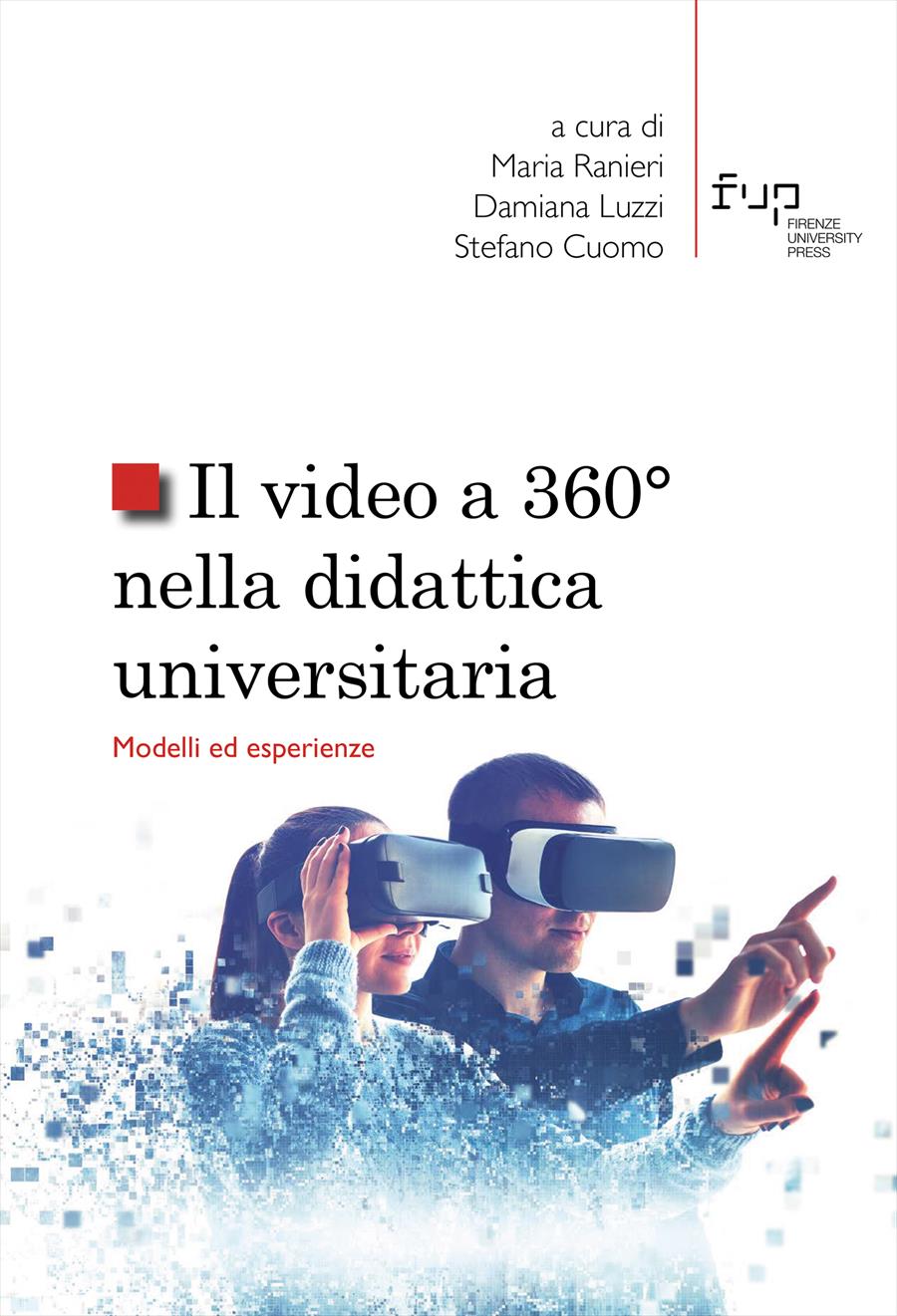- Il video a 360° nella didattica universitaria
- Edited by Maria Ranieri, Damiana Luzzi, Stefano Cuomo
Il video a 360° come supporto didattico. Un caso di studio nell’insegnamento di Analisi Sensoriale degli Alimenti
- Erminio Monteleone
- Lapo Pierguidi
- © 2022 Author(s) |
- CC BY 4.0
- DOI: 10.36253/978-88-5518-646-9.11
The chapter presents a case study based on the design, development, and testing of an interactive 360° video applied to the teaching of Sensory Analysis of Food at the University of Florence. The case study describes the design of 360° video storyboards and the creation of the video by the use of 360° cameras for reproducing a sensory laboratory environment. Video enrichment with Vivista, an educational software allowing lecturers to embed interaction points (e.g. quizzes, texts, images) within the 360° videos is also described. Different immersive modalities for the use of the videos with students in different contexts are described and discussed. The chapter concludes with a reflection on the opportunities that 360° videos may provide to university students for practice and experience.
- Keywords:
- 360 video,
- technology-enhanced learning,
- higher education,
- sensory science,
University of Florence, Italy - ORCID: 0000-0002-9149-969X
University of Florence, Italy - ORCID: 0000-0003-4116-5584
- Aguayo, Claudio, Thomas Cochrane, e Narayan Vickel. 2017. “Key Themes in Mobile Learning: Prospects for Learner-generated Learning through AR and VR.” Australasian Journal of Educational Technology 33, 6: 27-40. DOI: 10.14742/ajet.3671
- Balzaretti, Nicoletta, Andrea Ciani, Chelsea Cutting, Lisa O’Keeffe, e Bruce White. 2019. “Unpacking the Potential of 360degree Video to Support Pre-Service Teacher Development.” Research on Education and Media 11, 1: 63-69. DOI: 10.2478/rem-2019-000
- Boda, Phillip A., e Bryan Brown. 2020. “Priming Urban Learners’ Attitudes toward the Relevancy of Science: A Mixed‐methods Study Testing the Importance of Context.” Journal of Research in Science Teaching 57, 4: 567-96. DOI: 10.1002/tea.21604
- Huber, Tobias, Markus Paschold, Christian Hansen, Tom Wunderling, Hauke Lang, e Werner Kneist. 2017. “New Dimensions in Surgical Training: Immersive Virtual Reality Laparoscopic Simulation Exhilarates Surgical Staff.” Surgical Endoscopy 31: 4472-77. DOI: 10.1007/s00464-017-5500-6
- Kilteni, Konstantina, Raphaela Groten, e Mel Slater. 2012. “The Sense of Embodiment in Virtual Reality.” Presence: Teleoperators and Virtual Environments 21, 4: 373-87. DOI: 10.1162/PRES_a_00124
- Kosko, Karl W., Jennifer Heisler, e Enrico Gandolfi. 2022. “Using 360-degree Video to Explore Teachers’ Professional Noticing.” Computers & Education 180: 104443. DOI: 10.1016/j.compedu.2022.104443
- Myeung-Sook, Yoh. 2001. “The Reality of Virtual Reality.” In Proceedings Seventh International Conference on Virtual Systems and Multimedia, 666-74. DOI: 10.1109/VSMM.2001.969726
- Ranieri, Maria, Damiana Luzzi, Stefano Cuomo, e Isabella Bruni. 2022. “If and How Do 360-degree Videos Fit Into Education Settings? Results From a Scoping Review of Empirical Research.” Journal of Computer Assisted Learning. DOI: 10.1111/jcal.12683
- Repetto, Claudia, Serena Germagnoli, Stefano Triberti, e Giuseppe Riva. 2018. “Learning into the Wild: A Protocol for the Use of 360° Video for Foreign Language Learning”. Pervasive Computing Paradigms for Mental Health 253: 56-63. DOI: 10.1007/978-3-030-01093-5_8
- Rupp, Michael A., Katy L. Odette, James Kozachuk, Jessica R. Michaelis, Janan A. Smither, e Daniel S. McConnell. 2019. “Investigating Learning Outcomes and Subjective Experiences in 360-Degree Videos.” Computers & Education 128: 256-68. DOI: 10.1016/j.compedu.2018.09.015
- Saredakis, Dimitrios, Ancret Szpak, Brandon Birckhead, Hannah A. D. Keage, Albert Rizzo, e Tobias Loetscher. 2020. “Factors Associated with Virtual Reality Sickness in Head-mounted Displays: A Systematic Review and Meta-analysis.” Frontiers in Human Neuroscience 14, 3: 96. DOI: 10.3389/fnhum.2020.00096
- Tang, Anthony, e Omid Fakourfar. 2017. “Watching 360° Videos Together.” In Proceedings of the 2017 CHI Conference on Human Factors in Computing Systems, 4501-06. DOI: 10.1145/3025453.3025519
- Theelen, Hanneke, Antoine van den Beemt, e Perry den Brok. 2022. “Enhancing Authentic Learning Experiences in Teacher Education through 360-degree Videos and Theoretical Lectures: Reducing Preservice Teachers’ Anxiety.” European Journal of Teacher Education 45, 2: 230-49. DOI: 10.1080/02619768.2020.1827392
- Walshe, Nicola, e Paul Driver. 2019. “Developing Reflective Trainee Teacher Practice with 360-Degree Video.” Teaching and Teacher Education 78, 2: 97-105. DOI: 10.1016/j.tate.2018.11.009
- Yoganathan, Sutharsan, David A. Finch, Ed Parkin, e James S. Pollard. 2018. “360° Virtual Reality Video for the Acquisition of Knot Tying Skills: A Randomised Controlled Trial.” International Journal of Surgery 54, 6: 24-7. DOI: 10.1016/j.ijsu.2018.04.002
Chapter Information
Chapter Title
Il video a 360° come supporto didattico. Un caso di studio nell’insegnamento di Analisi Sensoriale degli Alimenti
Authors
Erminio Monteleone, Lapo Pierguidi
Language
Italian
DOI
10.36253/978-88-5518-646-9.11
Peer Reviewed
Publication Year
2022
Copyright Information
© 2022 Author(s)
Content License
Metadata License
Bibliographic Information
Book Title
Il video a 360° nella didattica universitaria
Book Subtitle
Modelli ed esperienze
Editors
Maria Ranieri, Damiana Luzzi, Stefano Cuomo
Peer Reviewed
Number of Pages
164
Publication Year
2022
Copyright Information
© 2022 Author(s)
Content License
Metadata License
Publisher Name
Firenze University Press
DOI
10.36253/978-88-5518-646-9
ISBN Print
978-88-5518-645-2
eISBN (pdf)
978-88-5518-646-9
Series Title
Studi e saggi
Series ISSN
2704-6478
Series E-ISSN
2704-5919
